In 1984 Sister Mildred Barker opined, "I almost expect to be remembered as a chair, or a table"1: an allusion to the furniture, for all the chairs, that popularly stand proxy for the United Society of Believers in Christ's Second Appearing, a.k.a. the Shakers, to whose members Sister Mildred Barker belonged.
Furniture, chairs, that for all their charms, and the great many convincing arguments in their favour, tend to restrict the popular view of and on the Shakers and thereby to limit popular appreciations of the community and its members.
With the exhibition The Shakers: A World in the Making the Vitra Design Museum, Weil am Rhein, expand one's view beyond that furniture and in doing so enable not only a clearer perspective of the Shakers, Shaker society and Shaker (hi)story as a component of European and American (hi)story, but also allow for more nuanced reflections on the furniture, for all the chairs, of the Shakers.......
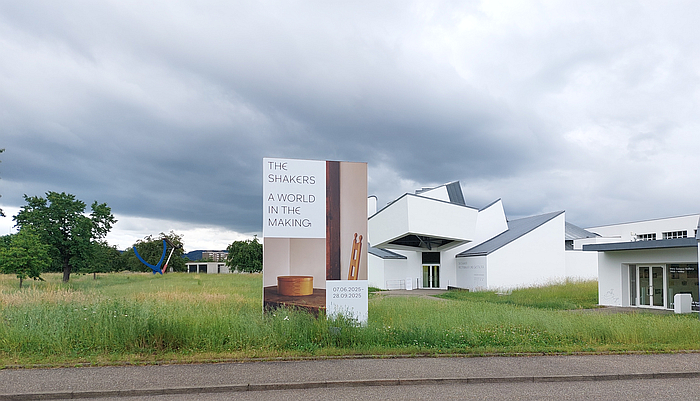
Tracing their (hi)story back to mid-18th century England, a (hi)story easy to locate in context of the Religious Society of Friends, a.k.a. the Quaker, movement that arose in the England of the second half of the 17th-century as, and summarising more than is prudent, a response to the conventions of the organised church and with a Lutheran rejection of the necessity of a clergy to mediate between the individual and God, of the right to individual communion with God, the story of the United Society of Believers in Christ's Second Appearing, a.k.a the Shakers, really begins in 1774 when a group of (+/-) seven members of a splinter Quaker group under the leadership of Ann Lee, a.k.a. Mother Ann Lee, departed England for America by way of, depending on your perspective, depending on whether or not your JD Vance, avoiding persecution in England for campaigning for their religious views or to avoid prosecution in England for disrupting church services by way of seeking to advance their religious views.
Religious views centred around principles of, and amongst others, communalism, pacifism, confession, simplicity, egalitarianism, self-sufficiency, respect for nature and celibacy; thus a society that, an argument can be made, we will make, means a William Morris's 1890 essay/novel News from Nowhere with its description of a simple, close to nature, craft based, self-sufficient, communal society, with very clear gender segregation if otherwise egalitarian, could actually be titled News from Shaker Country; whereby, yes, the active encouragement of sexual relationships, and slight hang to eroticism, in Morris's Nowhere does stand some what opposed to Shaker Country. A Shaker society that beyond such, more generally, contains strong elements of the Arts & Crafts movement Morris helped drive in late 19th century England, and which poses questions of the similarities between religious societies and communist societies.
And a Shaker community who, primarily, but not exclusively, on account of their independence from wider society, an independence not unrelated to their religious views and the lifestyle such demanded, developed and produced (near) all their goods of daily use.
Objects of daily use developed and produced by the Shaker community that form the basis of, and primarily populate, the narrative of The Shakers: A World in the Making and its exploration of the Shakers, of Shaker society.
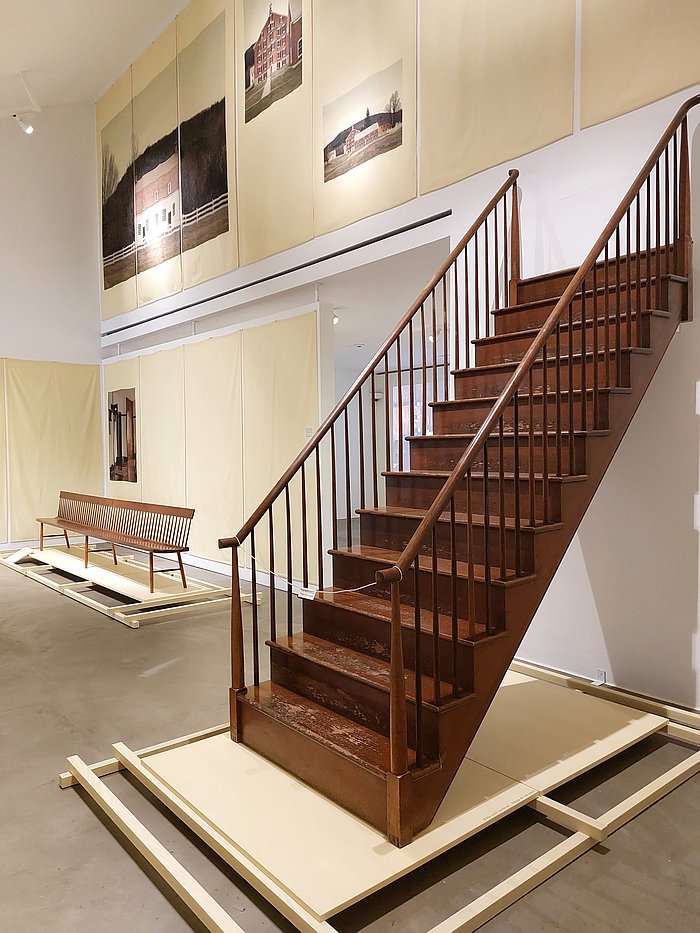
An exploration, as is less traditional as mandatary with Vitra Design Museum exhibitions, staged in four chapters, opening with The Place Just Right — all chapter titles being taken from quotes by members of the Shaker community, The Place Just Right being a line from the 1848 composition Simple Song — with its discussion on the basics of Shaker society via brief introductions to, for example, Music and Dance, including Shaker instruments, a Shaker songbook, or historic images that help elucidate how the United Society of Believers in Christ's Second Appearing acquired it's popular nickname: on account of the erratic, shaking, movement of its members during religious celebrations. Or certainly during its earliest years, less so in later years.
Or Architecture as illustrated by, for example, a ca. 1846 staircase salvaged from a Shaker house once, but no longer, to be found in the Mount Lebanon settlement that in being a Sisters' staircase, i.e. exclusively for female members of the family, helps explain the aforementioned gender segregation in that otherwise egalitarian society; photos of a number of Shaker houses commissioned as part of the exhibition, as part of the exhibition's intention to not only explore the Shakers, Shaker society, but to do so from today rather than employing the perspective and images of the past that have in many cases become lazily unchallenged stereotypes, have become as jaded and faded as the etchings and photographs they are based on, have become the chairs and tables Sister Mildred Barker was resigned to be remembered as; or plans of Shaker settlements including Alfred, Maine, Canterbury, New Hampshire, and the aforementioned New Lebanon, New York, that help introduce the singularities of Shaker urban planning.
And an opening chapter that also features a very full (hi)story of the Shakers in the form of a timeline from Anne Lee's birth in Manchester in 1736, over the establishment in north-west England of the so-called Wardley Group, that Quaker splinter group from which the Shakers developed; the establishment in 1776 of the first Shaker settlement a little to the north of Albany, New York; the Shakers first missionary tours through New York and New England in 1781-83; and from there the rise, rise, rise of the Shakers until in ca. 1845 the community reached its numerical zenith with some 6,000 Believers in 20+ settlements. Numbers that for all they sound relatively small, are relatively small, must be considered in context of the population of mid-19th century America, and also the populations of the myriad other religious sects of all hues and nationalities in that America. And in context of the Shakers' celibacy.
A numerical zenith whose fall, fall, fall to the contemporary, at time of writing, two living Shakers based in the only contemporary Shaker settlement of Sabbathday Lake, Maine, which are genuinely, in any context, very small numbers, is charted over episodes such as, for example, the establishment in 1858 of the first Black Shaker community in Philadelphia by the so-called Two Rebeccas - Cox Jackson and Perot; the publication in 1871 of the first Shaker periodical, a monthly publication for Believers and the wider world continued under various, more or less programmatic, names until 1900; the publication in 1933 by Edward Deming Andrews of the first book on the Shakers thus the origins of the popular reading of the Shakers, of a standardisation, a conventionalising, of Shaker (hi)story; or the influence of Shaker society and culture on the score by Aaron Copland and scenography by Isamu Noguchi for Martha Graham's 1944 ballet Appalachian Spring. An Isamu Noguchi who helps place the Shakers in the architecture and design of the USA of the second half of the 20th century.
A placement that, along with Morris's Nowhere, is a further one of a great many non-Shaker locations A World in the Making allows one to place the Shakers.

Having set the scene and explained what, where, how and why The Shakers are, A World in the Making moves on to the chapters When We Have Found A Good Thing, We Stick To It and Every Force Evolves A Form.
The latter exploring and discussing, if one so will, the practices that underscore and support daily life in Shaker settlements, with a particular focus on themes such as Care within the Shaker community, communal living involving as it needs must, all aspects of society, care that also reinforces the focus on the human as an individual within a community that is and was at the heart of the Shakers' world view, and as represented by, amongst other objects, a ca. 1830 wheelchair that in being a standard Shaker rocking chair with added wheels reminds very much of the standard wooden-framed armchair with added wheels Friedrich Nietzsche received as a wheelchair in 1899, as seen at Nietzsche Privat in context of Wohnen at Stiftung Klassik Weimar, that also helps elucidate the long path it has been to wheelchair design as an independent genre in its own right with the associated questioning of why such a long path; a pair of cradles, one for an adult, specifically for the elderly and/or terminally ill, which for all it is associated with attending to the elderly and sick with respect and decency, does looks a little like placing someone in a coffin before their time, the other for a child, a reminder that despite their celibacy Shaker settlements weren't child free-zones rather children arrived in the communities (primarily) via adoption of orphans and abandoned children. Or a late 19th century Zimmer frame crafted from turned maple rods whose visual expression places it very much in the wider Shaker canon and thereby enables it to elucidate not only the degree of social care within Shaker communities, but important aspects of Shaker production.
And also a focus on the Shakers as traders: for all that they existed independent of the temporal world they were never isolated from that world rather always interacted with it at various levels, and in their own way. And as Every Force Evolves A Form helps elucidate the Shakers were, for example, pioneers in the mass-market trading of seeds for home vegetable production, establishing a national distribution system in the 1790s, and were also early protagonists of herbal medicines, selling a variety of loose herbs and proprietary potions, preparations and balms for a cornucopia of conditions and complaints, and that very successfully as can be gleaned by the late-19th century poster on show in A World in the Making for Shakers' Blood Syrup, an alleged cure-all product that had nothing to do with the Shakers, that was, essentially, a plagiarism of a successful Shaker medicinal syrup cheekily marketed with the Shakers' name and imagery by way of seeking to profit from the Shakers fame, success and standing in the world of medicines.
A profiting from the fame, success and standing of the Shakers that not only helps elucidate the influence that relatively small group had in the development of America in the course of the 19th century, but a profiteering from the Shakers' fame, success and standing that, inarguably, is most visible in context of Shaker furniture; furniture initially made for their own use that was traded as a commodity from the late 18th century and those objects for which, as noted above, the Shakers are without question popularly best known, popularly most often identified with. Mistaken for. Objects that in the course of the 19th century non-Believers began to copy and market and sell; and thereby not only profited from the Shakers fame, success and standing but helped Shaker furniture become synonymous with American furniture. And also helped Shaker furniture restrict the popular view of and on the Shakers.
If furniture that for all it tends to restrict the popular view of and on the Shakers, does offer one of the easiest routes to approaching the Shakers, Shaker society, and of subsequently moving beyond that restricted view; as furniture of all ilks offers one of the easiest routes to approaching and expanding one's focus on any community and society.
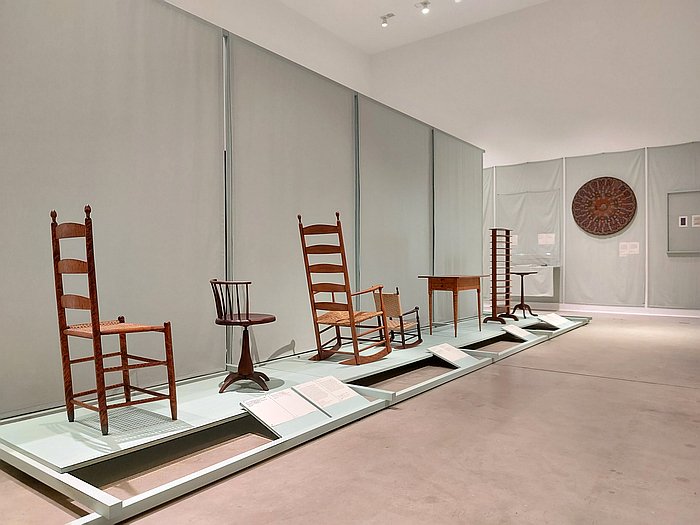
Furniture that is very much the focus of the chapter When We Have Found A Good Thing, We Stick To It; a title that for all it could imply a condition of dogmatic monosyllablism in the furniture of the Shakers, and a primacy of the stick/rod of the aforementioned Zimmer frame that can also be found in a great many of their chairs, as A World in the Making elegantly elucidates there is a real variety in the furniture of the Shakers, a variety born of the variety of needs and contexts in which furniture exists and the necessity of not being dogmatically monosyllabic in your furniture. Something a great many contemporary dogmatically monosyllabic furniture manufacturers could learn. Must learn.
Shaker furniture that, as one can glean from the many, but still far from comprehensive examples on display in A World in the Making - which isn't a complaint, simply an observation and a challenge to research more on your own - are defined by a reduction, a material and immaterial lightness, an elegance of construction, a standardisation, a visual and physical ease, a care and thought in conception, an acute awareness of function and use, a respect for the user. Are design from an age before design was a thing, before design could be defined, comprehended, practised.
And are also defined by a sobriety, humility, ease, and by a communalism, pacifism, confession, simplicity, egalitarianism, self-sufficiency, respect for nature and celibacy. Arose, so the popular telling of the (hi)story of the Shakers as it has existed for generations, from their religious beliefs. Represent, if one so will, a form defined by religion, are objects designed by religion, designed by religious views.
A popular telling of Shaker furniture as being rooted in Shaker beliefs we're not going to argue with, not least because furniture is intimately related with society: a decadent society realises decadent furniture; a technical society realises technical furniture; a violent society realises violent furniture, and the Cybertruck. A communal, pacifist, confessional, simple, egalitarian, self-sufficient, respecting of nature and celibate society realises communal, pacifist, confessional, simple, egalitarian, self-sufficient, respecting of nature and celibate furniture.
But for us that is also far, far too simple, is a telling that misses, is blinded to, ignores, other important contributing factors.
Important contributing factors whose omission from the popular narrative are also components of how and why the focus on the furniture of the Shakers skews perspectives on the Shakers, on Shaker society.

Factors A World in the Making in the manner in which it approaches the Shakers, Shaker society, allows one access to including, for example, through underscoring that the independence of the Shakers from wider society is and was also a reliance on that which they could produce themselves, both in terms of foodstuffs and objects of daily use. That the Shakers' world was one they made.
A state of affairs that on the one hand means their objects of daily use needs must be durable: replacing them is a burden on the community, that which is made must last, and needs to be easily repairable if it doesn't. And on the other hand means they needs must be producible via the tools and processes available, that they are achievable in context of your resources and possibilities: you can only produce that which you can. A demand, certainly in a communal society, that relies on having construction systems and production process that all, regardless of skill level, can follow and master to ensure the necessary quality and durability of the end goods. A necessity that very naturally leads to systems based on standardised components, a degree of machine mass production and a collective approach. And that in an 18th century America in which that wood and woody shrubs which grow in your near vicinity would be your only real option as a material.
Add those, and other aspects, into the mix, and regardless of who you are and how religious you are, you get furniture that has a lot of the elements of Shaker furniture. Less Every Force Evolves A Form as Every Practical Reality Evolves A Form. Which, arguably, is also a challenge to a Louis H Sullivan's 1896 claim that "form ever follows function, and this is the law".2 It is, but only once you define function, your available means of forming, skill at forming and ability to repeat that form. Which means it isn't.
The there is the fact that for all the USA Mother Anne Lee and her followers landed in in August 1774 was still very much the New World as far as Europeans were concerned, and a very Old World for a great many others, lest we forget, as we Europeans all too often do, the Shakers weren't the first Europeans on that continent, and far from the the first English: in 1620 the Mayflower landed in Cape Cod, Virginia, as the first ship bringing émigrés, religious refugees, from England, a ship that in addition to the 31 brave souls aboard also brought furniture.
Which opens up (at least) two further paths, voyages, of enquiry.
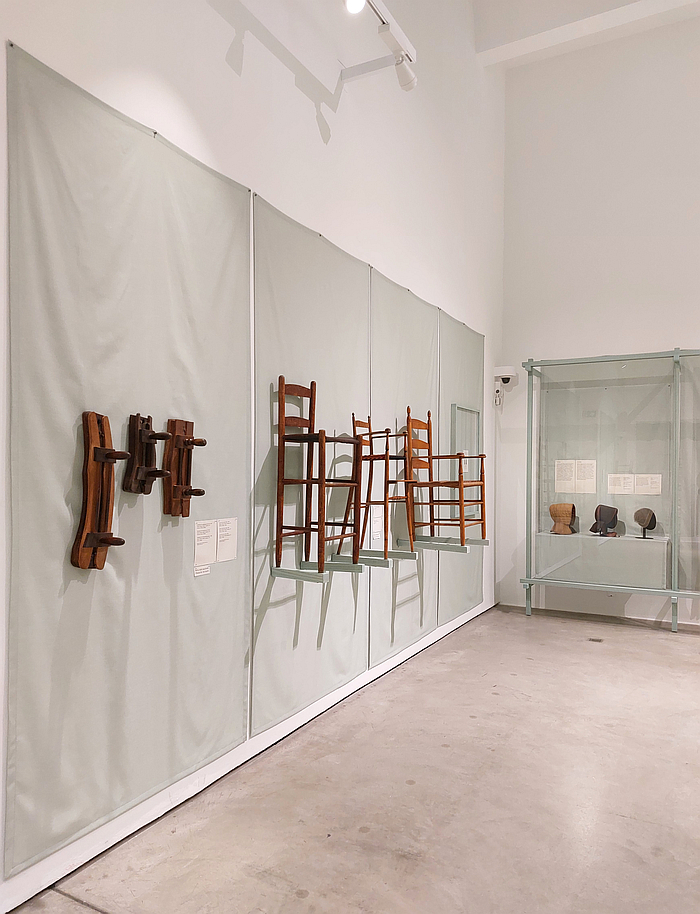
Firstly, as previously discussed in these dispatches, the Windsor chair becomes visible as an object in England and America in ca. 1720; a simultaneous appearance on both sides of the Atlantic that makes little sense unless the Windsor has a hidden, non-visible, (hi)story in the England of the late 17th century and was taken to America by the first English émigrés and then produced there as a simple affordable wooden chair. Windsor chairs that, unquestionably, in their use of turned rods joined via a simple round mortise-and-tenon system, and also in their origins as a collective construction process involving various artisans rather than being the work of a single skilled carpenter, and as being more a framework for developing seating objects than a seating object per se, very much echo in the furniture of the Shakers. In how far Mother Anne Lee et al would have been familiar with the Windsor in their native mid-18th century north-wast England is another question, but we suspect they would have been. And would certainly have encountered them in the English colonies of the eastern America of the late 1700s.
Secondly, not only was the Windsor chair known in the 18th century England Mother Anne Lee et al fled and in the 18th century America Mother Anne Lee et al landed, but also known in both, arguably known in England since the Middle Ages, were the so-called slat-back chair, a.k.a. the ladderback chair, and also a genre of rigidly qudratic armchairs chairs featuring turned wooden spindles and woven rush seats, that latter popularly known in America as Carver chairs after John Carver who sailed to America on the Mayflower and is alleged to have brought one with him. Carver chairs and ladderback chairs which were regularly highly ornate works where the responsible carpenter was often keen to demonstrate their craft and the owner keen to underscore their importance. Are often works with a lot of ego.
Unlike the Shaker ladderback and Carver chairs that can be enjoyed in A World in the Making, which are, without question, representatives of such genres, just devoid of show and ego and importance.
Thus there is a very strong argument to be made that Shaker chairs are a reduced, reserved version of such ornately turned and carpentered chairs; are ornate ladderback and Carver chairs realised in a much more modest form that is not only easier to produce by lay practitioners but that also reflect the communalism, pacifism, confession, simplicity, egalitarianism, self-sufficiency, respect for nature and celibacy the Shakers demanded. Are born of both religious and temporal demands. As, as A World in the Making neatly elucidates, are and were Shaker settlements and Shaker society.
And a reduction of the heavily ornate to the modestly reserved that not only echoes that way the Functionalist Modernists of the early 20th century reduced the ornamentative extremes of Art Nouveau of the late 19th/early 20th centuries, if for very different reasons to the Shakers' motivations, nor only that is the essence of an Adolf Loos' somewhat crudely formulated early 20th century argument that a reduction in ornamentation is an expression of cultural progression and maturity3, but also echoes the way in the early 19th century a Michael Thonet reduced the ornamentative extremes of the Rococo revival of the Vienna of the day to a sweeping silhouette.
A Michael Thonet who is as easily located in the furniture of the Shakers as the first Windsor chair makers; whereby we’re not suggesting any copying, any impropriety, on Thonet's part, we're not, and that not least because as with the Functionalist Modernists the motivations and paths of Thonet are clearly separate from those of the Shakers, are very singular to Michael Thonet. The comparison is however very instructive and informative and one that you should, must, make when viewing A World in the Making.
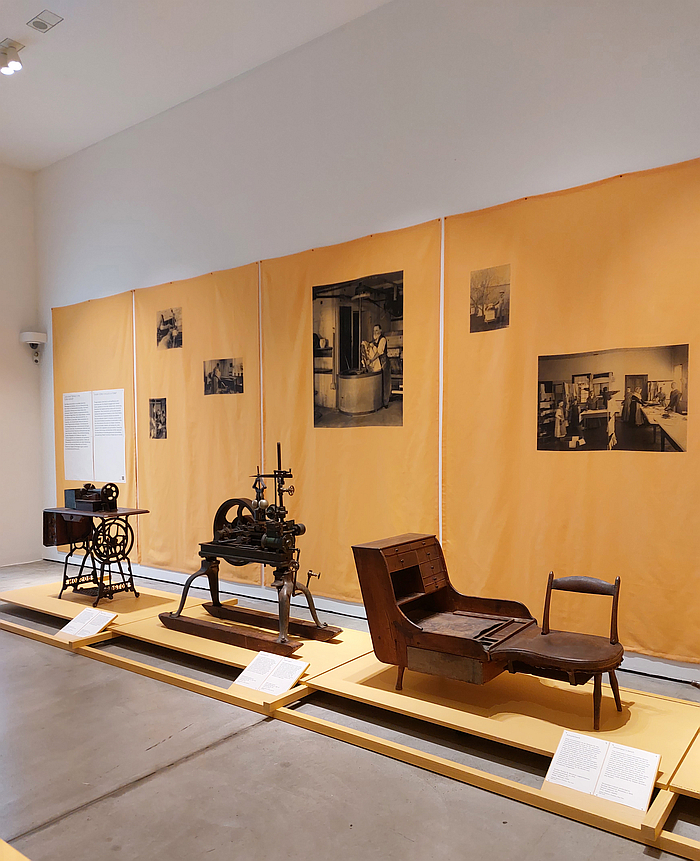
As is that with and to our contemporary age, not least the contemporary mania for 'Scandinavian' furniture. A 'Scandinavian' design concept that originated in the 1950s as a marketing line to stimulate the post 1939-45 War furniture industry, and partly motivated by an interest amongst American Mid-century Modernists in European craft furniture, before becoming the unquestioned thing it is today and that everyone can describe. A description AI in all is shallowness is about to carve in digital stone for all eternity. And a thing that everyone wants to own. Not least since someone discovered that if you add the word 'H****' it exponentially amplifies 'Scandinavian'. And the mass mania.
A Scandinavia, certainly, a Denmark, where, as A World in the Making notes, in 1944 Hans J Wegner, that so important and instructive furniture designer, so important and instructive chair designer, realised his J-16 rocking chair for FDB, an object that, if we're all being honest, is a Shaker rocking chair. Which, again, isn't to say Wegner was copying the Shakers, he wasn't, or at least not completely; rather, and much as he began his career studying ancient Chinese chairs, and other historic works, in the Copenhagen Kunstindustrimuseet, Arts & Crafts Museum, and then reimagined them, he was transposing that which the Shakers did to contemporary Denmark for contemporary Danish society. FDB, for example, being the Danish Co-operative Society, appropriately, and who, while they weren't necessarily as collectively cooperative as the Shakers, were about producing affordable, functional, meaningful goods for a mass public in a relatively poor European nation; a question whose answer Wegner identified in Shaker furniture. Much as Børge Mogensen identified it in stick back chairs and Windsors. And in Shaker furniture.
And if Hans J Wegner designed a Shaker rocking chair in 1944, where does that place everything Wegner designed after 1944? A 1944 that is before the 1950s, that much hyped "Golden Age" of furniture design in Denmark and from which so many Danish manufacturers rely for their contemporary portfolios rather than commissioning contemporary designers to design chairs for contemporary society. As Wegner, Mogensen, et al once did.
Or alternatively, where does that place all furniture designed in Denmark after 1927? The year, as A World in the Making also notes, an exhibition of Shaker of furniture was held in Copenhagen, an exhibition viewed by, amongst others, Kaare Klint, that Grand Doyen, and highly influential Professor, in context of the development of furniture design as a practice in 20th century Denmark. A Kaare Klint who, amongst other positions, was an advocate for, and practitioner of, learning from the past, that position that "Problemerne er ikke saa nye, de er i mange Tilfælde løst før"4, 'the problems are not so new, they have in many cases been solved before'. A position, arguably, also held by the Shakers.
And a Kaare Klint whose 1936 chairs for the Bethlehem Church in Copenhagen for all that they resemble Shaker chairs are actually modelled on vernacular chairs from rural southern Italy, on a vernacular ladderback chair. A Bethlehem Church chair that as the Church Chair was in the Fritz Hansen programme from 1936 to 2004, making it one of the company's longest produced models and therefore, one must assume, commercially most successful models. Certainly commercially successful enough to justify its place in the portfolio for neigh on seven decades.
Which all offers another perspective on the importance of not just vernacular furniture in the development of furniture design, see again the Windsor chair, but also on the ubiquity of reduced wooden furniture, as does, for example, the reduced wooden furniture of contemporaries of the aforementioned William Morris such as, for example Ford Madox Brown or Philip Webb and as produced by Morris & Co., that reinforces that with reduced wooden furniture the important isn't the visuals, they're near universal, and have been since time immemorial, thus essentially meaningless, but that the important with reduced wooden furniture is always the whats, the whys, the wherefores. That which is inherent in the object's genesis and justification.
In which context The Shakers are, as A World in the Making deliciously underscores, particularly instructive.
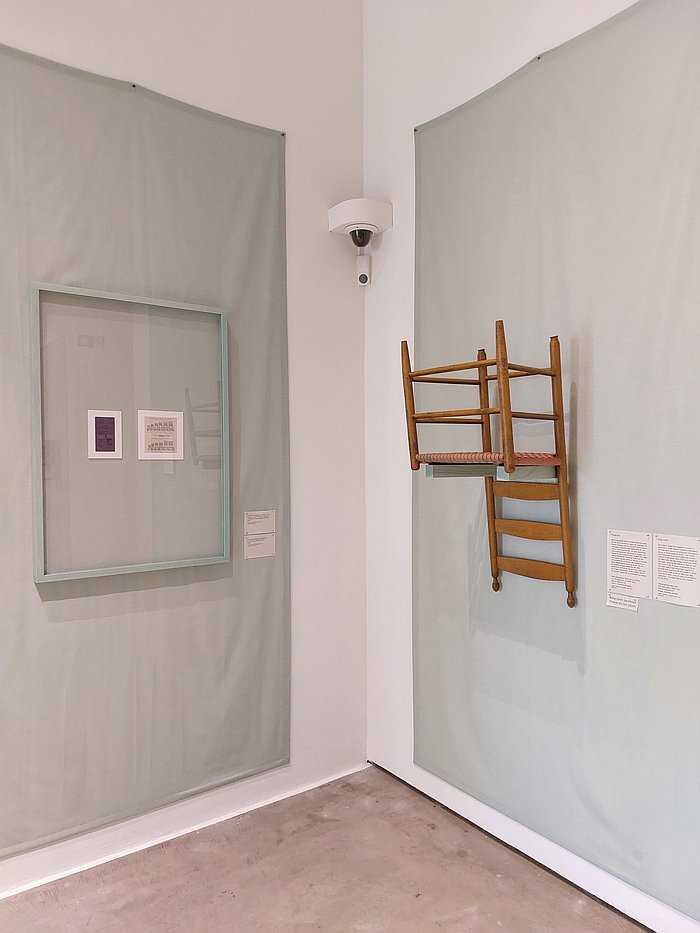
Including in context of their Tilting chair, an object, a concept, one is invited to get up close and personal with in A World in the Making; and a concept that is a joy not only in every sense of the word but that actively develops new definitions of joy the more you engage with it.
A concept that is not only the functionality, the approach to the question of functionality, the appreciation of the relationships between a chair and the physical space it occupies, the appreciation of use of a chair, of how a chair can be more than a surface for sitting on, inherent in the ball and socket joint in the foot of the back legs that enables, empowers, the development of a construction that one can tilt backwards in without scuffing the floor, thereby enabling that leaning back in a chair we're all prone to do, and the shifting in sitting position that today is understood as important, without damage to chair or room; but is also the development of that ball and socket joint from a simple wooden construction to a brass construction without losing anything of its elegance and charm. Whereby, admittedly, we've never actually sat in Shaker Tilting chair and can thus make no comment on the sitting experience, far less the tilting experience, but as concept, a construction, an elucidation of furniture design, an elucidation of what furniture design should be, as an extension of seating and sitting, a true joy.
And also, arguably primarily, in their hooks, an object genre that today is often seen as an optional accessory, a graphic or artistic addition to a space, something that can be added to a wall, but needn't be, take-it-or-leave-it; but hooks, pegboards, that are not only highly instructive of the Shakers approach, and of the Shakers' world view and positions, but are at the centre of their interior design. Are, if one so will, and/or your feeling particularly droll, the conceit on which Shaker interior design is hung. Shaker hooks one has to get know to understand Shaker furniture and interiors. And Shaker society.
Hooks that for all they are simple, unassuming wooden pegs create a framework for a room in that they enable a system that allows a room to be furnished to the individual needs of the user, even in a collective community, in that (near) everything is hung on hooks, everything is designed to be hung on hooks, and moved and/or replaced as and when required, including, for example, storage solutions of all types, mirrors, brushes, tools, not to mention clothing and hats. And also the (majority of) chairs, whose backrests are so formed so as to enable hanging, something important not least in context of sweeping the floor.
Cleanliness being next to Godliness and all that.
A Godliness that for all it is and was at the heart of the Shaker community, is and was ever present in Shaker daily life, and is omnipresent in A World in the Making, is inescapable when viewing in A World in the Making, isn't dominant in A World in the Making's narrative.
Until the final chapter: I Don't Want to be Remembered as a Chair, an echo of, a resistance to, Sister Mildred Barker's resignation.
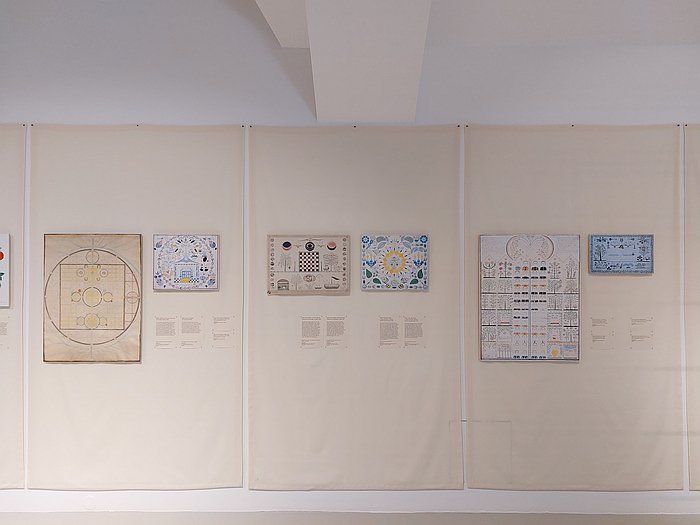
In context of the Vitra Design Museum exhibition Nike: Form Follows Motion we compared the upper floor of the Vitra Design Museum's Gehry Building, with it arches, alcoves, hidden light et al, as being formally analogous to a place of worship: in A World in the Making it actual is on account of, and amongst other objects, Danish designer Chris Liljenberg Halstrøm's My Work Station / My Prayer Room, an implication of that contemporary alter at which so many of us, forced or unforced, worship daily, and also an evocation of the links between Shaker furniture and the concept of 'Scandinavian' design, and by American artist Amie Cunat's 2nd Meetinghouse, a recreation of the Meetinghouse of the Shaker settlement at Sabbathday Lake, that not only in transposing interior components to the exterior questions concepts of within and outwith that are becoming increasingly complicated, but that being itself a space within but outwith the Vitra Design Museum's Gehry Building is an easily taken invitation to sit and reflect on that which you have seen, to discuss with others what you've seen, to create a community, to reflect on the fact that the community who brought forth all that which you have experienced is represented today by just two individuals, two individuals who meet in the space you are now in and have similar yet different conversations on Shaker society and Shaker (hi)story; two individuals who run the very real risk of being "remembered as a chair, or a table". A fate that having reached the final chapter you appreciate would be wholly unjust.
Albeit a space that would be much more conducive to reflection and consideration were it without the loud, endless, rendition of the aforementioned Simple Song, a song that Aaron Copeland used in his aforementioned score for Appalachian Spring, that plays on constant loop on the top floor of the Vitra Design Museum. At the risk of sounding like we're picking a fight with the curators, which we're not, we're as pacifist as the Shakers; but, while 'tis without question "a gift to be simple" and 'tis without question "a gift to be free", it shouldn’t be a gift to be able to think in a museum, shouldn't be a gift not to have someone shouting uncouthly in your ear to the point of physical distraction, while visiting a museum. It should be a given. Whereby, yes, we did spend more time in the final chapter than most visitors will spend in the whole exhibition, so our experience isn't and wasn't typical. But with such a short song we'd argue you need a pause between renditions, otherwise your brain starts seeping out your ears. Or put another way, Simple Song's use in the final chapter "'tis a Gift", in the German sense. Still, that said, it is preferable to having Nelly try to sell you trainers in the Vitra Design Museum: "Air Force Ones", "Air Force Ones", etc...
And works by Chris Liljenberg Halstrøm and Amie Cunat that are two of the seven projects commissioned by the Vitra Design Museum, and their cooperation partners Milwaukee Art Museum and the Institute of Contemporary Art Philadelphia, from contemporary artists and designers in context of A World in the Making by way of reflecting on that which the Shakers are, were, seek to be, in differentiated contexts.
Seven projects that also include, for example, Power - Every Movement is Sacred a film/dance performance by American choreographer Reggie Wilson that not only reflects on movement, dance, singing, clapping et al as components of religions of all hues, but also on the Black Shakers of Philadelphia, a further component of the contribution of non-Whites to the development of the contemporary USA that gets lost in the focus on the contributions of Whites; or Dutch designer Christien Meindertsma's Burial Basket in which the location of care at the centre of Shaker society is re-imagined in context of traditional Dutch wicker weaving to realise a wicker coffin that not only offers less intrusive burials but that also stimulates a questioning of the flow of vernacular craft processes through the ages, something also very inherent in the furniture of the Shakers, the society of the Shakers.
Seven art and design projects that very much help broaden the presentation, allow for discussion and discourse on a wider range of subjects, allow for shifts of perspective on that which is presented and discussed, remind of all that we still have to learn through and from the Shakers, once we've learned to view the Shakers beyond their furniture, while also expanding the experience of viewing the exhibition without encroaching on the core exhibition and its academic approach and argumentation.
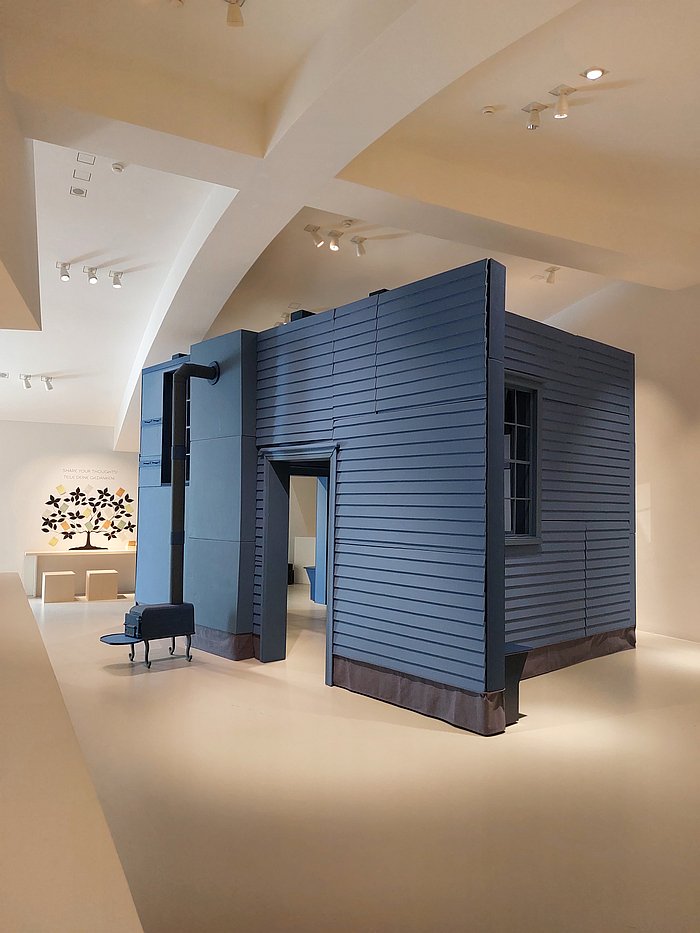
If we're being honest, which we always try to be, we've long been converts to the Shakers: that may have come through, at least a little bit, in the above, but we hope while maintaining a professional distance to the exhibition itself. And indeed we had a major trip to and through Shaker country and Shaker (hi)story planned for 2020: then 2020 happened and we barely left our flat, and since when have simply been unable to re-plan. Thus we were always going to delight, critically as ever, in any collection of Shaker objects, in any discussion on the Shakers and Shaker society populated by such a wide variety of objects.
Objects that aside from the aforementioned furniture, posters/prints and staircases also includes, and amongst many other items: clothing, including a woollen cardigan employing the so-called Shaker Knit, a rib stitch developed in the late 19th century that helps underscore the innovation of the Shakers in all dominions where they are and were active; a collection of oval, steam bent, wooden boxes, objects that that Shakers started making at the turn of the 18th/19th centuries, that are one of the most distinctive of Shaker objects beyond their furniture, one of the Shakers most successful commercial goods, and which for all their glaring formal and material similarities pre-date by a good generation the rise of veneer based plywood as a material for objects of daily use in Europe and America, a rise as discussed by and from Plywood: Material of the Modern World at the V&A Museum, London; or a number of self-built machines, including a steam engine and a flagroot cutter, that indicate that the Shakers are and were anything but rejectors of technology, rather embrace the possibilities within the constraints of their religious beliefs, and also that their independence from the wider worlds means they are and were as dependent on the themselves for the machines they use as for the things those machines produce. As does a radio built in ca. 1925 by one Elder Irving Greenwood. An object that conventional tellings of the Shakers has no knowledge of.
Thus a presentation that while, for us, it was always going to be a delight, should, hopefully be enlightening, illuminating, revelatory, for anyone who has spent less time with the Shakers. Or who confuses Shakers for a American furniture manufacturer.
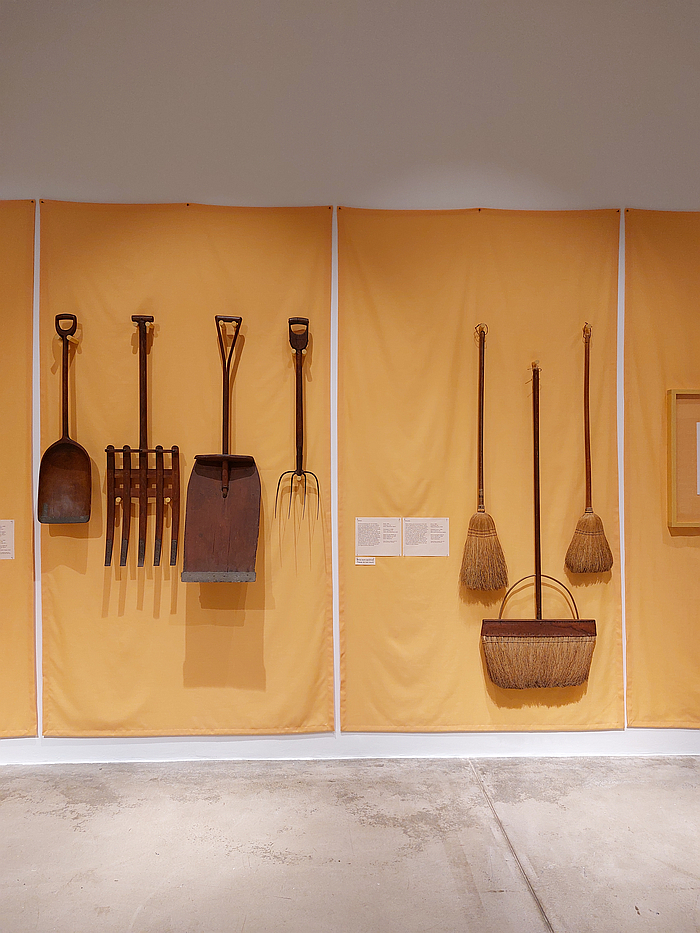
Enlightening in context of the (hi)story of furniture design, of the many problems with the contemporary linear narrative of the (hi)story of furniture design, on the fallacy of pigeon-holing in furniture design and on the real necessity to engage directly with objects, designers, processes, to engage in individual communion with furniture objects and not via the disingenuous crutch of throwaway terms that alone serve book publishers and the furniture industry, not via the conventions of the organised discourse.
And that similarly forces reflections on a religion as design as exemplified by the Shakers, that today is design as religion, see, not only the worshipping of the furniture of the Shakers as something not of this world, when it very much is, but also, for example, the veneration of the furniture of the Bauhäusler with Gropius's Dessau school building as its high cathedral as discussed by and from Kang Sunkoo – Sacristy at Stiftung Bauhaus Dessau, or the aforementioned adoration of 'Scandinavian' design. On design as a religion celebrated by a global congregation at the alter of Instagram.
As a religious movement the Shakers remind us, or can remind us one we stop viewing the Shakers as furniture, of the need for more secular relationships with furniture, of not making furniture a deity, of engaging with furniture as an object not as a symbol.
And also of remembering that design is but an approach to problem solving, exists for the benefit humans, for the benefit of human society, not for the benefit of commerce.
Much as the Shakers admonish that that which we today call Social Design is just living socially, of living with a respect and responsibility for others, of considering others in our daily dealings even to our own impediment. Social Design as something we've had to invent by way of combating, correcting, an inherent selfishness that has crept through society: we design our societies and they design us.
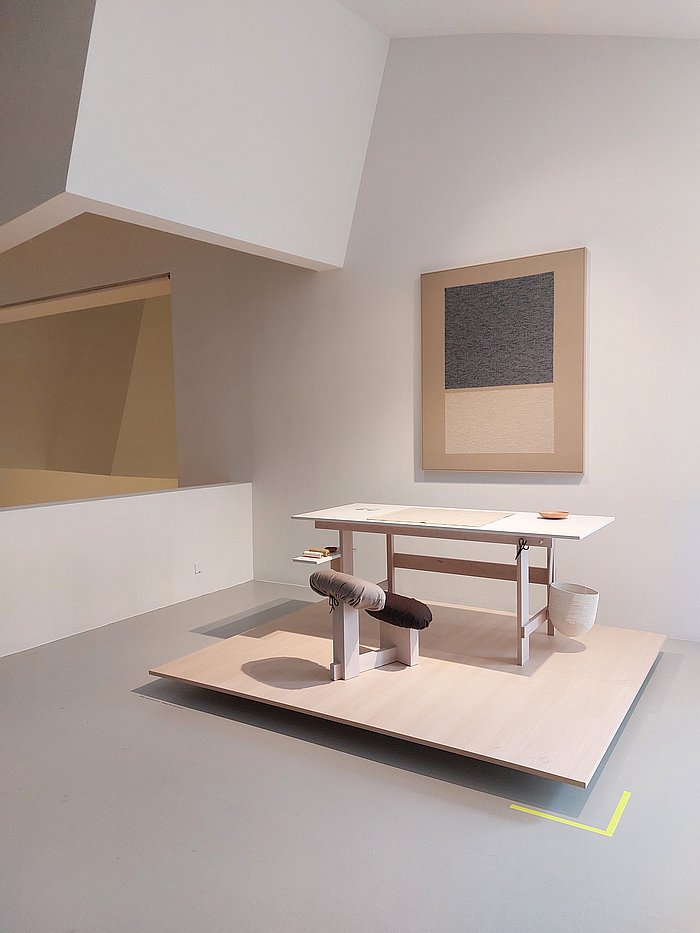
Thoughts which bring one to a contemporary USA with only two Shakers, and reflections on the place and role of the Shakers in the development of that USA over the past 250 years; of the Shakers as being one of those Protestant sects on which the contemporary USA was founded and from which it grew. And the Shakers as developers of furniture and knitwear that is widely considered typically American, that is without question a component of American self-identity, of an America that is Great. Albeit a contemporary USA that, certainly across large swathes and in the corridors of power, stands diametrically juxtaposed to the world of the Shakers. A contemporary USA in which the Shakers, in many regards, are as unwelcome as they were in 18th century England. A contemporary USA that seems determined to disavow the Shakers and their beliefs. And which makes their current population not just precarious, but symbolic, poetically, tragically, so.
But primarily enlightening in context of the Shakers, of Shaker society, of Shaker (hi)story, is a presentation that very simply, unobtrusively, satisfyingly shifts your focus from the furniture of the Shakers to the wider contexts, to the Shakers as a community then, now, and (possibly) in the future, and in doing so effortlessly allows for differentiated perspectives on the Shakers, allows the Shakers to contribute to contemporary discourses they are often excluded from, bequeaths the Shakers a contemporaneous the focus on their furniture regularly denies them.
And thereby negates not only the risk of anyone confusing the Shakers for a furniture making collective, but the risk of anyone remembering Sister Mildred Barker, and all of her brethren and sisters, as a chair, or as a table. Allows us to remember them as they are and were, as humans.
And to appreciate the Shakers as a community who made a world that poses important questions of the world the rest of us have made. And what we could make that world.
The Shakers: A World in the Making is scheduled to run at the Vitra Design Museum, Charles-Eames-Str. 2, 79576 Weil am Rhein until Sunday 28th September, following which it will travel on to first the Institute of Contemporary Art Philadelphia and subsequently Milwaukee Art Museum, before, we strongly suspect, enjoying another couple of presentations globally.
In addition a catalogue featuring numerous essays and specially commissioned photographs is available in German and English.
Further details can be found at www.design-museum.de

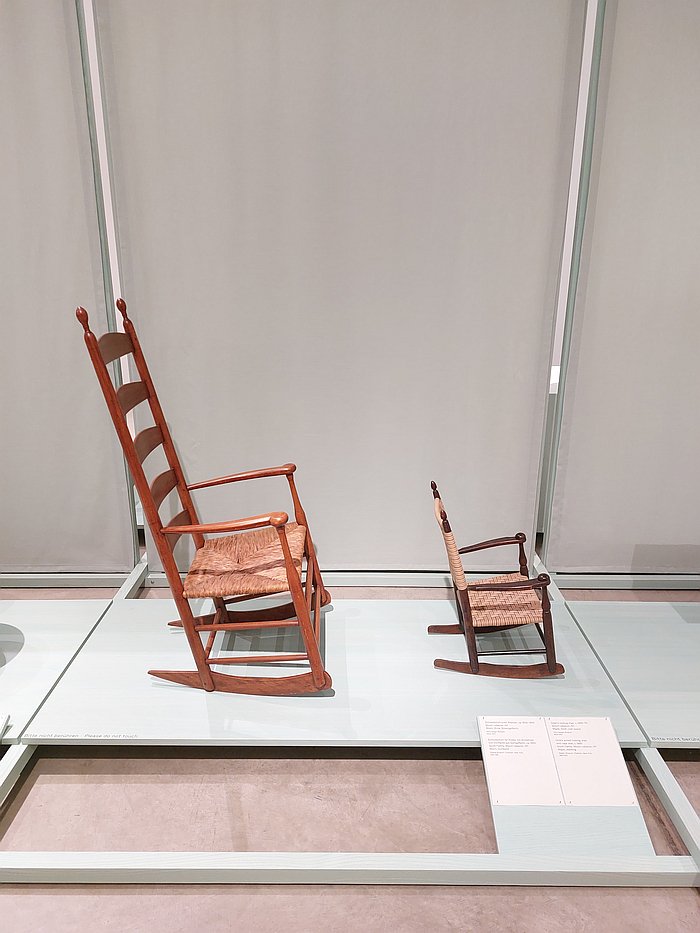
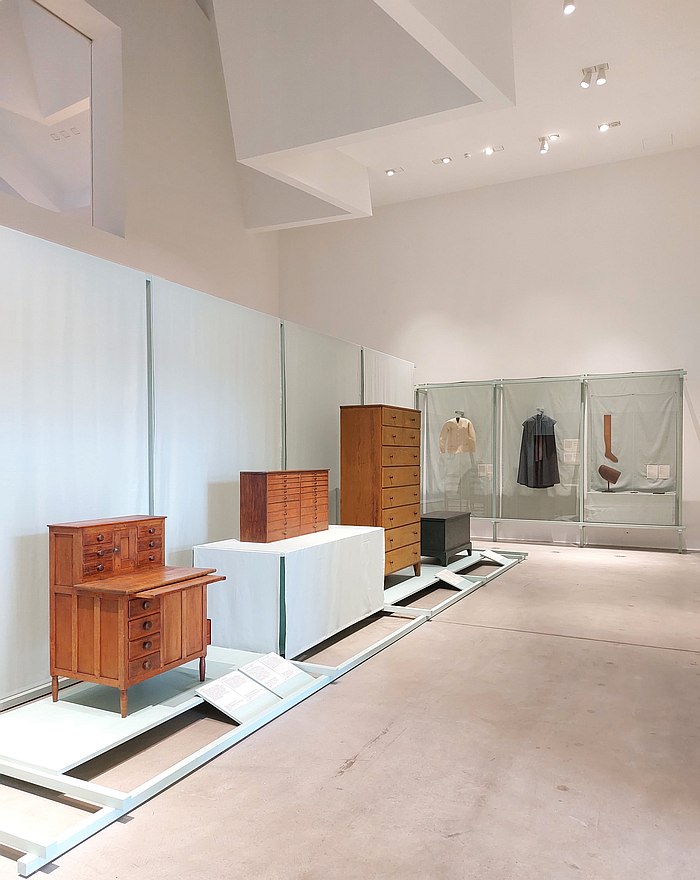
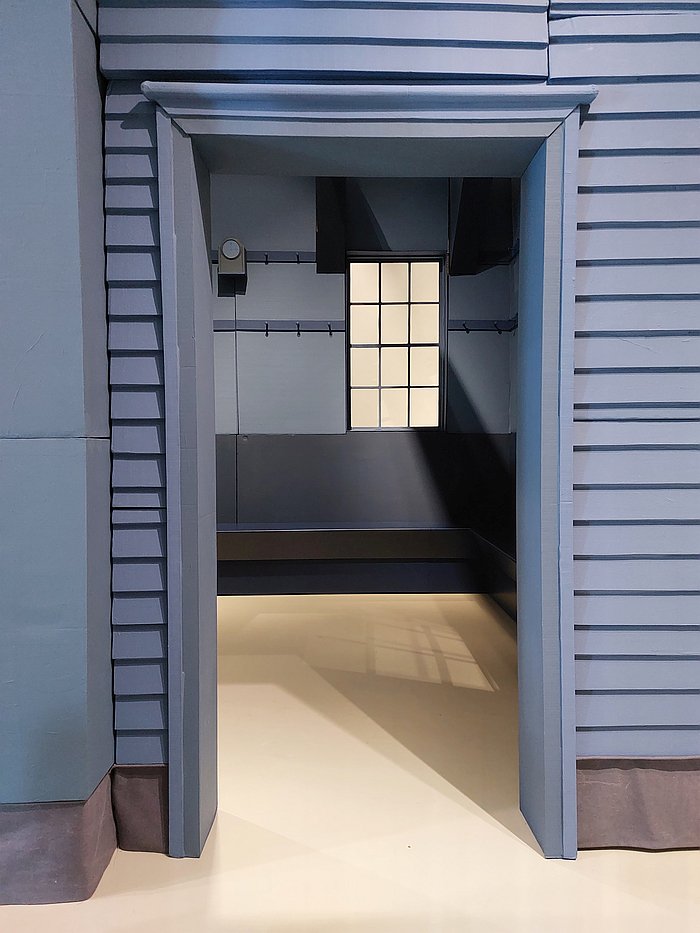
1Sister Mildred Barker in Ken Burns and Amy Stechler Burns, The Shakers: Hands to Work, Hearts to God, Florentine Films, 1984, quote comes at ca 7 minutes.
2see, Louis H. Sullivan, The Tall Office Building Artistically Considered, Lippincott's Monthly Magazine, March 1896, page 403ff
3see, Adolf Loos Ornament und Verbrechen, 1908, available in numerous formats and editions and translations.
4Kaare Klint, Undervisningen i Møbeltegning ved Kunstakademiet, Arkitekten månedshæfte, October 1930, page 203